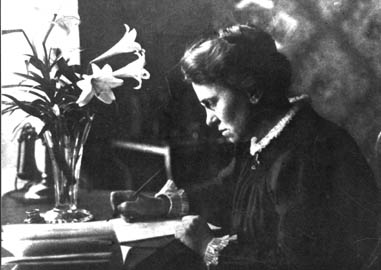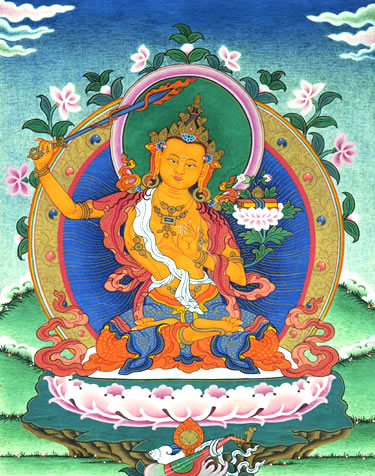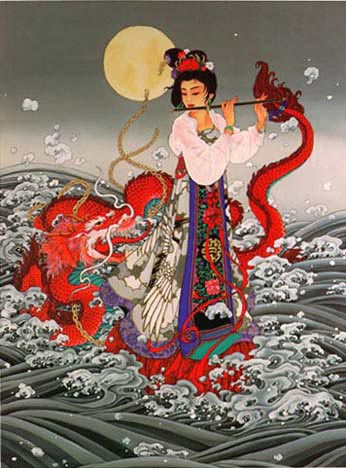Dancing
In The Lotus Sutra, whenever people start to wake up they start dancing. It’s nice to be part of a lineage that insists on dancing. Emma Goldman (proto-feminist, writer, activist) thought so too.

“At the dances I was one of the most untiring and gayest. One evening a cousin of Sasha [Alexander Berkman], a young boy, took me aside. With a grave face, as if he were about to announce the death of a dear comrade, he whispered to me that it did not behoove an agitator to dance. Certainly not with such reckless abandon, anyway. It was undignified for one who was on the way to become a force in the anarchist movement. My frivolity would only hurt the Cause.
I grew furious at the impudent interference of the boy. I told him to mind his own business, I was tired of having the Cause constantly thrown into my face. I did not believe that a Cause which stood for a beautiful ideal, for anarchism, for release and freedom from conventions and prejudice, should demand the denial of life and joy. I insisted that our Cause could not expect me to become a nun and that the movement should not be turned into a cloister. If it meant that, I did not want it. “I want freedom, the right to self-expression, everybody’s right to beautiful, radiant things.” Anarchism meant that to me, and I would live it in spite of the whole world—prisons, persecution, everything. Yes, even in spite of the condemnation of my own comrades I would live my beautiful ideal. [Living My Life (New York: Knopf, 1934), p. 56]
Nemesis
The Buddha explains that the person who helped him wake up was none other than Devadatta, his nemesis. Your nemesis is responsible for your awakening. Devadatta did the two worst things anyone could do: he tried to kill a buddha (several times no less), and he tried to break up the sangha, the community. All of these malicious efforts helped to wake up the Buddha.
Unique
The Lotus Sutra emphasizes how unique you are, whew, what a relief after all those grey Zen reminders of how ordinary everyone is. Everyone is a buddha, and everyone can wake up. Devadatta, for instance, behaves so badly, but even he can become a buddha. How does he become a buddha? He recognizes someone else who is a buddha. Only a buddha and a buddha can realize The Lotus Sutra. Instead of trying to become a buddha, all you have to do is see how your nemesis is a buddha.
Underneath the Underneath
One of the core teachings of the dharma is that there is no such as an atom. The world is infinitely divisible. Even the smallest portion of the world can be even further divided. There is no centre, and nothing eternal. Some say that when you get underneath everything there is sunya or emptiness. But sunya also means swollen – it’s not nothing. And it’s not something you can hold in your hands. Under analysis everything keeps breaking down into finer and finer bits. Underneath the underneath are butterflies and gardens and chainsaws.
Dragon Princess
Every time The Lotus Sutra is preached a stupa rises up into the sky and hovers over everything. Inside that funereal monument is all time and space. In other words, everyone you’ve ever been, and everyone you’ve ever met are all here in this moment. They can be hard to see because they’re all up in the stupa, you need a kind of super power to see them. How do you turn on your super powers? You recognize a buddha. Whenever you make this recognition, a stupa with everyone in it appears. All time and space are right here.
Manjushri
Have you ever been to a party a little too long and everyone is starting to fade and you decide to go but just then the host says, “Wait a minute, there’s someone coming I think you really want to meet.” This is what the Buddha says about Manjushri, a figure often depicted like Kwan-Yin, leaning over sideways with a tool. In this instance, she wields a sword of love, it is the same sword that Patanjali carries. It is so sharp that it can cut through bad habits, or people that you don’t need to carry in your life any longer. But it only cuts out of love.

Manjushri emerges from the sea, and pays respects to the two buddhas in the stupa. The kingdom of the sea is where The Lotus Sutra resides. From the naga (serpent) worlds, the Chinese, who didn’t have serpents, translated them as dragons. The holiest texts of emptiness come from the bottom of the ocean.
Bodhisattva Wisdom Accumulated asks Manjushri: In all your travels under the sea, has anyone followed The Lotus Sutra so completely, so rigorously, that they instantly awoke?
Manjushri replies: “There is the daughter of the dragon king Sagara, who has just turned eight. Her wisdom has keen roots and she is good at understanding the root activities and deeds of living beings. She has mastered the dharanis, has been able to accept and embrace all the storehouse of profound secrets preached by the Buddhas, has entered deep into meditation, thoroughly grasped the doctrines, and in the space of an instant conceived the desire for bodhi and reached the level of no regression.”
Regression or backsliding is when the arhats would big up on concentration practice but their ethics weren’t quite so clean, then they would start to regress. Wisdom Accumulated is a bit troubled by this response though, because after all it took the Buddha thousands of years to attain enlightenment, how could this little girl manage it in just a moment? He voices his doubts and at that moment the girl appears. Then Shariputra weighs in with an ugly misogynistic screed, saying that women are lesser than men, that women’s bodies are soiled and defiled, that a woman is subject to “the five obstacles” (she can’t become a Brahma heavenly king, a king Shakra, a devil king, a wheel-turning sage king or a Buddha).
Dogen: “When we speak of the wicked there are certainly men among them. When we speak of noble persons, these surely include women. Learning the Law of Buddha and achieving release from illusion have nothing to do with whether one happens to be a man or a woman.”

The dragon girl bows to the Buddha and gives him a precious jewel that he accepts immediately. Then she turns to Wisdom Accumulated and Shariputra – two of the heaviest hitters of the early Buddhist world – and says, “I presented the precious jewel and the World-Honoured One accepted it – was that not quickly done?
They reply, “Very quickly!”
The girl said, “Employ your supernatural powers and watch me attain Buddhahood. It will be even quicker than that!”
“At that time the members of the assembly all saw the dragon girl in the space of an instant change into a man and carry out all the practices of a bodhisattva… and attaining impartial and correct enlightenment. With the 32 features and the 80 characteristics, he expounded the wonderful Law for all living beings everywhere in the ten directions.”
Everywhere
The Buddha actually touches and touched every place in the universe, even the smallest moments, down to the size of a mustard seed. The place you’re sitting right now is also the place where the Buddha sits. And you don’t have to live the Buddha’s life to become the Buddha, you can have your own life. There’s no place in reality where the Buddha didn’t wake up – there’s no place in your life that can’t be awakened. That’s the lesson we need to learn over and over.
Everything you’ve done in the past is sacred and holy. Space is holy. There’s no space the Buddha didn’t practice in, and there’s no space in your life that the Buddha isn’t practicing right now.

“We are all many persons. Some of these people we know and others we don’t—only someone else knows them. Some of these people we like and some of them we don’t like. Some of them we long for, and others we want to run away from. All of this is music; it’s the music of our lives if we could only stop to listen. Music doesn’t have any meaning; you can’t explain it. Eating a meal doesn’t have any meaning either, but if there’s no eating there’s no life, and if we don’t hear the music we can’t dance. This is our practice—to eat our meals and clean up; to dance to the music of our lives, each one in our own way, and then die when it’s time…
Zhaozhou didn’t leave the monastery for 40 years, until Nanquan’s death. He was about 60 years old and felt it was time to test his practice, to go to the graduate school of Buddha-dharma as the monks of those days did, traveling, going to different temples, meeting different masters; a time-tested and important practice of Zen. And this is how you do it—you spend 40 years in one place and when you gradually get the hang of that, you go around to other places to try to understand more. When he embarked on this pilgrimage, Zhaozhou made the famous saying, which I admire very much, “In this pilgrimage if I meet an old person of 80 or 90 years, experienced in the Dharma, who needs to learn something from me, I will teach. And if I meet a young girl of seven years old who has something to teach me, I will sit at her feet and learn.” Norman Fischer (http://www.everydayzen.org/index.php?Itemid=27&option=com_teaching&topic=Zen+Koans&sort=title&studyguide=true&task=viewTeaching&id=text-132-91)
Imagination
Because there is nowhere that the Buddha has not practiced, there’s nobody who can’t be enlightened. How do they get enlightened? By the way that you see them – as being on the way to awakening. Even though The Lotus Sutra has emphasized a gradual awakening, brought about by years, even lifetimes, of practice, here it suggests that there can be rapid awakening. And this time it’s a girl who leaves home to receive teachings. You can only watch this girl become a Buddha if you have super powers. This is exactly what your super powers are: to see how others are Buddhas. You can use your imagination to see deeper than ever before. Maybe Buddha nature is your imaginative capacity to stretch around experience and see where its Buddha nature resides.
There is a tradition that asks you to use the imagination of your heart as a lens. On this groundless ground. We are always on the look out for a better place to stand, but we’re standing right here and this is where we have to work. And the Buddha is standing right here with us. In sitting practice the deep practice is how we need so much humility to get underneath our lives and see how we’re always defending ourselves against ourselves all the time.
Women Rule OK?
In 406 AD China to speak about an 8-year-old girl becoming a Buddha is a radical gesture. The fact that Krishnamacharya taught yoga to householders and women was a radical gesture – and this was only 50 years ago! Over time many Indian deities become half-man, half-woman, and then they become women. The Buddha becomes male and female. Kwan-Yin changes from a man to a woman. This particular chapter in The Lotus Sutra so inspired some sects in the Zen Tendei school that they made statues of Kwan-Yin and the dragon girl and placed them at the centre of their new temple.
Under Water
In mythologies past and present, to go under water means going into the unconscious. 2500 years ago nobody went physically down into the water, what was down there exactly? But the dragon girl came from this place, had made this pilgrimage. This awakening means going really deep into your body, into the places that you’re blind, into your difficult relationships. Awakening happens at the bottom of the ocean – but do we really want to go down there?
Going to the bottom of the ocean makes us human.

The Moment by Sharon Olds
When I saw the dark Egyptian stain,
I went down into the house to find you, mother
Past the grandfather clock, with its huge ochre moon
Past the burnt sienna woodwork, rubbed and glazed
I went deeper and deeper down into the body of the house
Down below the level of the earth
And I found you there where I had never found you
By the washtubs, your hand thrust deep in soapy water
And above your head the blazing windows at the circus of the ground
You looked up from the iron sink,
A small haggard pretty woman of 40, one week divorced
“I’ve got my period mom,” I said and saw your face
abruptly break open and glow with joy
“Baby,” you said, coming toward me, hands out
And covered with tiny delicate bubbles like seeds.

